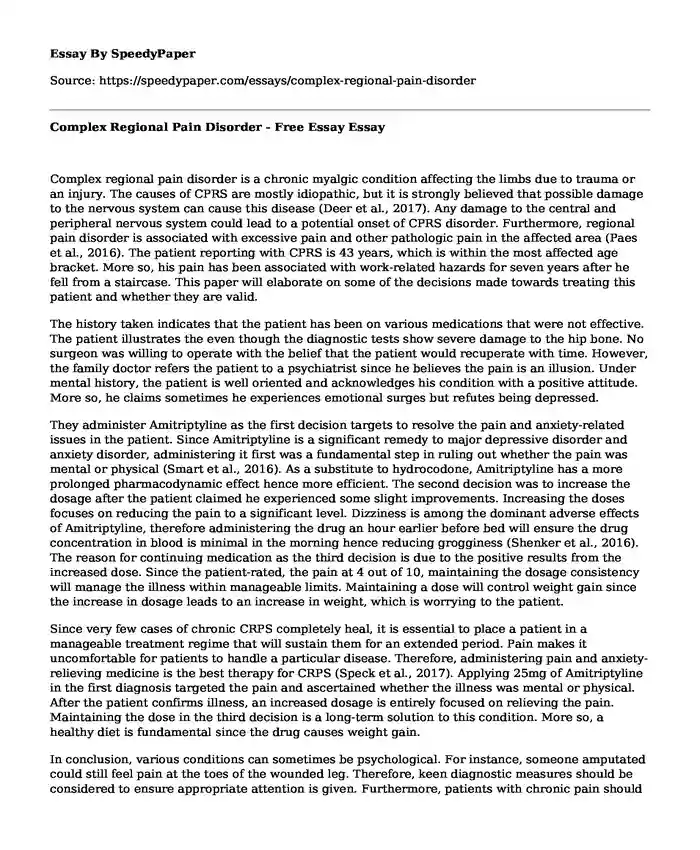Complex regional pain disorder is a chronic myalgic condition affecting the limbs due to trauma or an injury. The causes of CPRS are mostly idiopathic, but it is strongly believed that possible damage to the nervous system can cause this disease (Deer et al., 2017). Any damage to the central and peripheral nervous system could lead to a potential onset of CPRS disorder. Furthermore, regional pain disorder is associated with excessive pain and other pathologic pain in the affected area (Paes et al., 2016). The patient reporting with CPRS is 43 years, which is within the most affected age bracket. More so, his pain has been associated with work-related hazards for seven years after he fell from a staircase. This paper will elaborate on some of the decisions made towards treating this patient and whether they are valid.
The history taken indicates that the patient has been on various medications that were not effective. The patient illustrates the even though the diagnostic tests show severe damage to the hip bone. No surgeon was willing to operate with the belief that the patient would recuperate with time. However, the family doctor refers the patient to a psychiatrist since he believes the pain is an illusion. Under mental history, the patient is well oriented and acknowledges his condition with a positive attitude. More so, he claims sometimes he experiences emotional surges but refutes being depressed.
They administer Amitriptyline as the first decision targets to resolve the pain and anxiety-related issues in the patient. Since Amitriptyline is a significant remedy to major depressive disorder and anxiety disorder, administering it first was a fundamental step in ruling out whether the pain was mental or physical (Smart et al., 2016). As a substitute to hydrocodone, Amitriptyline has a more prolonged pharmacodynamic effect hence more efficient. The second decision was to increase the dosage after the patient claimed he experienced some slight improvements. Increasing the doses focuses on reducing the pain to a significant level. Dizziness is among the dominant adverse effects of Amitriptyline, therefore administering the drug an hour earlier before bed will ensure the drug concentration in blood is minimal in the morning hence reducing grogginess (Shenker et al., 2016). The reason for continuing medication as the third decision is due to the positive results from the increased dose. Since the patient-rated, the pain at 4 out of 10, maintaining the dosage consistency will manage the illness within manageable limits. Maintaining a dose will control weight gain since the increase in dosage leads to an increase in weight, which is worrying to the patient.
Since very few cases of chronic CRPS completely heal, it is essential to place a patient in a manageable treatment regime that will sustain them for an extended period. Pain makes it uncomfortable for patients to handle a particular disease. Therefore, administering pain and anxiety-relieving medicine is the best therapy for CRPS (Speck et al., 2017). Applying 25mg of Amitriptyline in the first diagnosis targeted the pain and ascertained whether the illness was mental or physical. After the patient confirms illness, an increased dosage is entirely focused on relieving the pain. Maintaining the dose in the third decision is a long-term solution to this condition. More so, a healthy diet is fundamental since the drug causes weight gain.
In conclusion, various conditions can sometimes be psychological. For instance, someone amputated could still feel pain at the toes of the wounded leg. Therefore, keen diagnostic measures should be considered to ensure appropriate attention is given. Furthermore, patients with chronic pain should not be prescribed with potent drugs since these drugs could cause harmful effects to these individuals. Long term solutions are essential in the recuperating process.
References
Deer, T. R., Levy, R. M., Kramer, J., Poree, L., Amirdelfan, K., Grigsby, E., ... & Scowcroft, J. (2017). Dorsal root ganglion stimulation yielded higher treatment success rate for complex regional pain syndrome and causalgia at 3 and 12 months: a randomized comparative trial. Pain, 158(4), 669.
Paes, C. R., Faria, G. R., Tinoco, N. A., Castro, D. J., Barbarino, E., & Lourenço, S. O. (2016). Growth, nutrient uptake and chemical composition of Chlorella sp. and Nannochloropsis oculata under nitrogen starvation. Latin American Journal of Aquatic Research, 44(2), 275-292.
Shenker, N., Goebel, A., Rockett, M., Batchelor, J., Jones, G. T., Parker, R., ... & McCabe, C. (2015). Establishing the characteristics for patients with chronic Complex Regional Pain Syndrome: the value of the CRPS-UK Registry. British journal of pain, 9(2), 122-128.
Smart, K. M., Wand, B. M., & O'Connell, N. E. (2016). Physiotherapy for pain and disability in adults with complex regional pain syndrome (CRPS) types I and II. Cochrane Database of Systematic Reviews, (2).
Speck, V., Schlereth, T., Birklein, F., & Maihöfner, C. (2017). Increased prevalence of posttraumatic stress disorder in CRPS. European Journal of Pain, 21(3), 466-473.
Cite this page
Complex Regional Pain Disorder - Free Essay. (2023, Oct 15). Retrieved from https://speedypaper.com/essays/complex-regional-pain-disorder
Request Removal
If you are the original author of this essay and no longer wish to have it published on the SpeedyPaper website, please click below to request its removal:
- Reflection Paper Sample at No Charge: HIV/AIDS
- Addictions and Social Connections, Free Essay Sample
- Clinical Research Paper Example of a Client with ADHD
- Essay Sample on Pathopharmacology
- Paper Example. Serotonin Norepinephrine Reuptake Inhibitors Drug
- Ankylosing Spondylitis - Paper Example
- Essay Sample on Impact of Technology on Global Health
Popular categories





